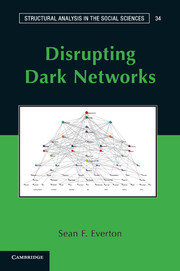Book contents
- Frontmatter
- Contents
- Figures
- Tables
- Preface
- Acknowledgments
- Part I Introduction
- 1 Social Network Analysis: An Introduction
- 2 Strategic Options for Disrupting Dark Networks
- Part II Social Network Analysis: Techniques
- Part III Social Network Analysis: Metrics
- Part IV Social Network Analysis: Advances
- Part V Conclusion
- Appendix 1 The Noordin Top Terrorist Network
- Appendix 2 Glossary of Terms
- Appendix 3 Multidimensional Scaling with UCINET
- Appendix 4 The Just War Tradition
- References
- Index
1 - Social Network Analysis: An Introduction
Published online by Cambridge University Press: 05 April 2013
- Frontmatter
- Contents
- Figures
- Tables
- Preface
- Acknowledgments
- Part I Introduction
- 1 Social Network Analysis: An Introduction
- 2 Strategic Options for Disrupting Dark Networks
- Part II Social Network Analysis: Techniques
- Part III Social Network Analysis: Metrics
- Part IV Social Network Analysis: Advances
- Part V Conclusion
- Appendix 1 The Noordin Top Terrorist Network
- Appendix 2 Glossary of Terms
- Appendix 3 Multidimensional Scaling with UCINET
- Appendix 4 The Just War Tradition
- References
- Index
Summary
Introduction
While notions of social structure can be found in the writings of classical social theorists such as Auguste Comte, Emile Durkheim, Karl Marx, Herbert Spencer, and Max Weber, Georg Simmel is generally seen as the intellectual forbearer of social network analysis (SNA). Simmel ([1908] 1955, [1908] 1971) argued that to understand social behavior we must study patterns of interaction, and he offered penetrating insights into the nature of secret societies (1950b), the differing dynamics of dyads and triads (Simmel 1950a, c), how increasing social complexity has led to concomitant rise in individualism ([1908] 1955), as well as others. While Simmel's theoretical contributions continue to influence the discipline today, SNA's early formal development can be traced to two major strands (Prell 2011; Scott 2000): the work of (1) social psychologists, such as Fritz Heider, Kurt Lewin, and Jacob Moreno (Heider 1977; Lewin 1951; Moreno 1953), who emphasized how organized patterns shape how we see and interpret the world; and (2) social anthropologists, such as Siegfried Nadel (1957) and Alfred Radcliffe-Brown (1940), who focused on the relationship between social patterns and social structure and who, in turn, influenced the research of social scientists such as Elton Mayo (1933, 1945; see also Roethlisberger and Dickson 1939), W. Lloyd Warner (Warner and Lunt 1941), John Barnes (1954), Elizabeth Bott (1957), and J. Clyde Mitchell (1969). These individuals did not create a distinct SNA paradigm, but their efforts laid the groundwork for its development at Harvard in the 1960s and 1970s, in an effort led by sociologist Harrison White and his students, including Ronald Breiger, Ivan Chase, Bonnie Erickson, Mark Granovetter, Michael Schwartz, and Barry Wellman (Freeman 2004; Prell 2011; Scott 2000). White, who also earned a Ph.D. in theoretical physics, emphasized the need for an empirically based social science that unapologetically focused on social phenomena. He argued that sociology, in spite of its claims to study social phenomena, was beholden to individualistic forms of analysis that drew conclusions based on the aggregated characteristics of individuals, often aided by statistical analysis of survey data. This, he believed, was a mistake. Thus, along with his students, he developed an approach that drew on case studies to focus on social relations and the patterns that emerge from them. The result is what we now know as social network analysis, and the discipline has blossomed ever since (Freeman 2004; Prell 2011). Social network analysts have created their own organization (International Network for Social Network Analysis), launched their own journals (Connections, Social Networks, and the Journal of Social Structure), gathered annually in either North America or Europe (Sunbelt meetings), and produced a number of monographs on SNA (de Nooy, Mrvar, and Batagelj 2005, 2011; Degenne and Forsé 1999; Knoke and Yang 2007; Scott 2000; Wasserman and Faust 1994).
- Type
- Chapter
- Information
- Disrupting Dark Networks , pp. 3 - 31Publisher: Cambridge University PressPrint publication year: 2012
- 1
- Cited by

